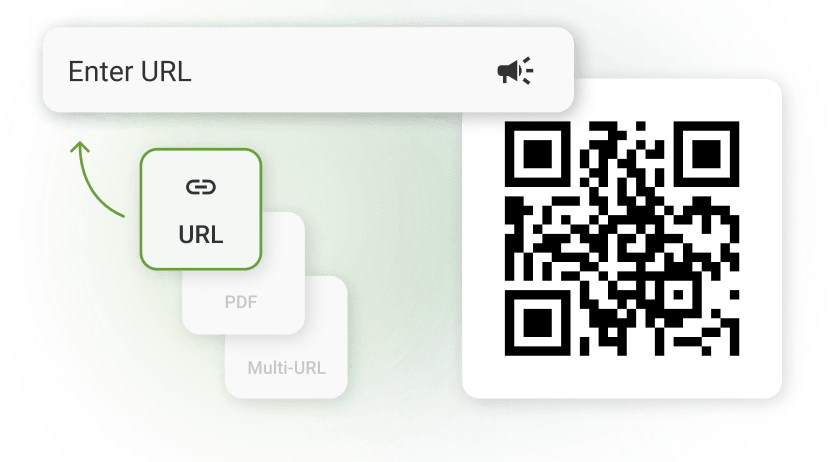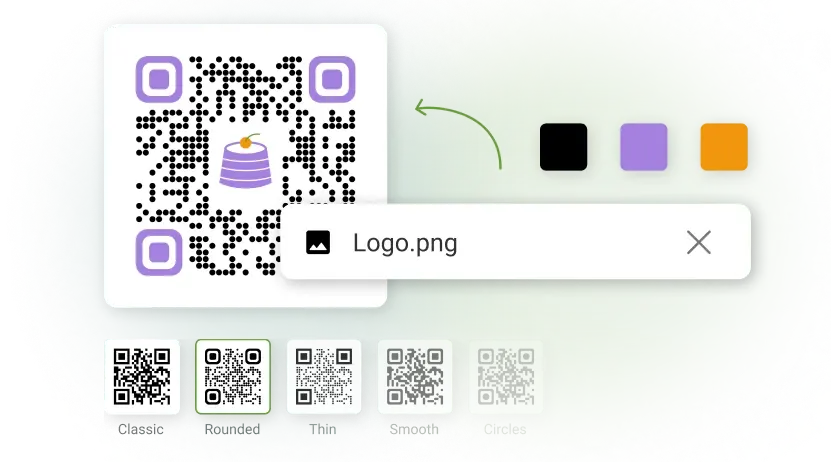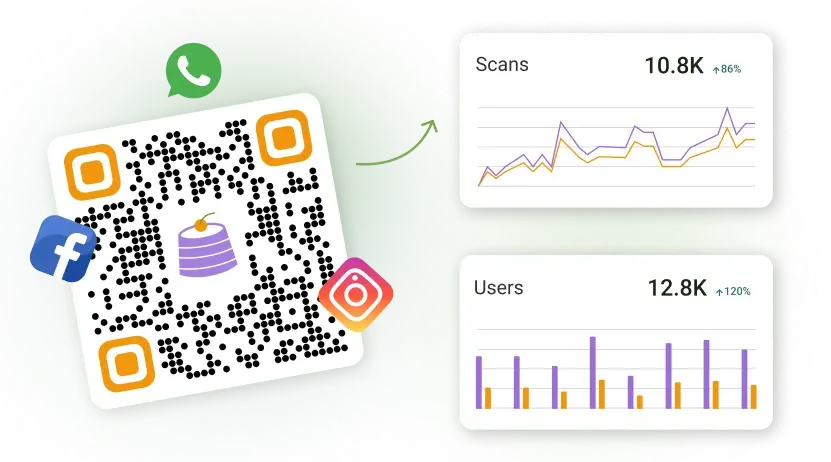59% of businesses face the issue of QR Codes not scanning properly or load times being too slow. This is especially true for QR Codes printed outside or on product packaging.
To help you avoid this problem, we’ve put together a practical guide on best practices while printing QR codes. In this article, we’ll get into ideal sizing, format, and step-by-step instructions to create your QR code for printing. Let’s get started!
Best practices for printing QR Codes (checklist)
The effectiveness of a printed QR Code depends on a few key best practices. Following these ensures a reliable scanning and a seamless user experience.
- Optimal dimensions and scanning distance: A QR Code’s physical size and viewing distance are paramount for scannability.
- High-resolution printing: The clarity and sharpness of the printed QR Code directly impact its readability.
- Strong contrast and color selection: Adequate contrast between the QR Code and its background is essential for scanner recognition.
- Effective error correction (Reed-Solomon code): Built-in redundancy ensures the QR Code remains scannable even with minor damage or obstruction.
- Adequate quiet zone: A clear, unobstructed border around the QR Code is crucial for proper detection.
- Strategic placement: The location and visibility of the QR Code significantly influence scan rates.
- Concise data (Short URLs): Less complex data within the QR Code leads to faster and more reliable scanning.
- Clear call to action: Guiding users with an instruction encourages interaction.
- Consider scan time: The duration users have to scan the code impacts its design and data complexity.
- Avoid clutter: Placing multiple QR Codes in close proximity can create confusion and hinder scanning.
- Thorough testing: Comprehensive testing across various conditions is vital before mass printing.
- Printing method and material selection: The chosen printing technique and surface material affect the final quality and scannability.
Let’s look at each of these aspects in detail.
1. Optimal dimensions and scanning distance
The physical dimensions of a QR Code are critical for its scannability. While the smallest QR Code ever created measured an astonishing 5.38 µm² (seven times smaller than a red blood cell), a practical minimum size for a scannable QR Code is generally 1 cm x 1 cm (approximately 0.4 inches x 0.4 inches).
The ideal size of a QR Code is directly proportional to the scanning distance. A widely accepted formula for determining the minimum required size is:

This means that for a scanning distance of 30 inches, the QR Code should be at least 3 inches x 3 inches. This ensures readability with typical smartphone cameras.
Here’s a table illustrating ideal dimensions for common print use cases, considering typical scanning distances:
| Use Case | Minimum Size (in inches) | Recommended Size (in inches) | Scanning Distance (in inches) |
| Business Cards | 0.4 x 0.4 | 0.8 x 0.8 | 4 – 6 |
| Product Packaging | 0.6 x 0.6 | 0.8 x 0.8 | 6 – 12 |
| Flyers and Brochures | 0.8 x 0.8 | 1.2 x 1.2 | 12 – 20 |
| Posters (Indoor) | 1.2 x 1.2 | 2 x 2 | 20 – 40 |
| Billboards (Outdoor) | 6 x 6 | 10 x 10 | 60 + |
| T-Shirts / Fabric | 0.8 x 0.8 | 1.2 x 1.2 | 6 – 12 |
| Vehicle Wraps | 3 x 3 | 4 x 4 | 72 – 120 |
It is important to note that these are general guidelines, and the actual minimum scannable size can vary based on factors such as the smartphone camera quality, lighting conditions, and the complexity of the QR Code’s data.
2. High-resolution printing
To prevent distortion and ensure clear scannability, QR Codes must be printed at a high resolution. A printing resolution of at least 300 DPI (dots per inch) is recommended for most print applications. For larger formats like billboards, higher resolutions may be necessary depending on the printing method.
Vector-based file formats, such as EPS (Encapsulated PostScript), SVG (Scalable Vector Graphics), or vector-based PDF (Portable Document Format), are ideal for printing QR Codes. These formats allow for infinite scalability without any loss of quality or pixelation, ensuring crisp lines and sharp modules regardless of the final print size. Raster formats like JPEG or PNG should only be used if they are of very high resolution and the final print size is carefully considered to avoid pixelation.
3. Strong contrast and color selection

Maintaining a high contrast between the QR Code’s foreground (the modules) and background is crucial for scanner readability. The general rule is to use a darker color for the QR Code against a lighter background, or vice versa. For example, a black QR Code on a white background offers the highest contrast and is universally recommended.
While colored QR Codes can be aesthetically appealing, ensure the color combination provides sufficient contrast. Avoid using similar shades or highly reflective colors that might make it difficult for scanners to distinguish the modules. The QR Code generator, lets you know if your code has any scannability issues beforehand.
4. Effective error correction (Reed-Solomon code)

QR Codes incorporate a sophisticated error correction mechanism, known as Reed-Solomon code, which allows them to remain scannable even if they are partially damaged, obscured, or dirty. This feature is achieved through redundant data stored within the QR Code’s modules. There are four standardized error correction levels, each offering a different degree of data recovery:
- Level L (Low): Recovers up to 7% of data. Suitable for smaller prints like business cards, product packaging, or RSVP cards where damage is less likely.
- Level M (Medium): Recovers up to 15% of data. Ideal for general use cases such as brochures or indoor posters.
- Level Q (Quartile): Recovers up to 25% of data. Useful for surfaces that may experience some distortion or minor damage, such as T-shirts or water bottles.
- Level H (High): Recovers up to 30% of data. Best for environments where the QR Code is prone to significant damage, scratching, or extreme weather conditions, such as outdoor billboards or warehouse signage.
For printed QR Codes, especially those exposed to potential wear and tear, selecting a higher error correction level is advisable. Keep in mind that a higher error correction level increases the number of modules in the QR Code, making it appear denser. This may necessitate a slightly larger overall QR Code dimension to maintain scannability.
5. Adequate quiet zone
A quiet zone, also known as a “silent zone” or “clear space,” is a mandatory clear border of white space (or the background color) surrounding all four sides of a QR Code. This margin helps scanners properly identify the QR Code by separating it from surrounding text, images, or other design elements.
The recommended size for the quiet zone is at least four modules (the smallest squares within the QR Code) wide on all sides. It is crucial to ensure no text, images, or designs intrude into this quiet zone, as this can severely impair the QR Code’s scannability.
6. Strategic placement
The placement of a printed QR Code is as important as its design and quality. Strategic placement maximizes visibility and ease of scanning, ultimately leading to higher engagement. QR Codes have the potential to increase engagement by 3-4 times, making their placement a critical factor.
Consider the user’s perspective when deciding on placement. Avoid positions that are too high, too low, or in awkward angles, which may make it difficult for users to comfortably scan the code with their smartphones. Optimal placement typically involves:
- Line of sight: Position the QR Code at eye level or within the user’s natural scanning range.
- Accessibility: Ensure there is enough physical space for a user to approach and scan the code without obstruction.
- Relevant context: Place the QR Code near relevant product information that encourage its use.
Common placements include:
- Print advertisements: Magazines, newspapers, flyers, brochures.
- Product packaging: Boxes, labels, bottles.
- Promotional stickers: On products, windows, or displays.
- Business cards: For quick contact or portfolio access.
- Outdoor signage: Billboards, bus stops, store windows.
- Fabric: T-shirts, promotional apparel.
- Metal: Etched or printed on machinery, plaques.
- Plastic: Loyalty cards, product inserts.
7. Concise data (Short URLs)

The amount of data encoded within a QR Code directly impacts its visual density. A longer URL or extensive information results in a more complex QR Code with a greater number of modules, making it appear “cluttered.” A cluttered QR Code can be slower to scan and more susceptible to errors.
To optimize scannability, it is highly recommended to use short URLs. Many QR Code generators, particularly those offering dynamic QR Codes, automatically shorten URLs. Alternatively, third-party URL shortening services can be utilized. A concise URL significantly reduces the data encoded, resulting in a cleaner, faster-scanning QR Code.
8. Clear call to action
A QR Code without a clear call to action (CTA) may be ignored by potential users. A compelling CTA provides a directive, encouraging interaction and clarifying the purpose of scanning the code. Simple phrases like “Scan to Learn More,” “Scan for Our Menu,” “Watch the Video,” or even a prominent social media logo can significantly increase scan rates. A well-designed CTA can overcome user hesitation and lead to higher engagement.
9. Consider scan time

For QR Codes displayed in motion or in transient environments, such as on vehicle wraps or billboards alongside a freeway, the “scan time” is a critical consideration. While scanning a QR Code typically takes only a few seconds, factors like the amount of encoded data, the size of the QR Code, and its placement influence the time available for a successful scan.
For such dynamic applications, it is essential to prioritize larger QR Code dimensions and minimize the amount of encoded data. A less dense QR Code will scan faster, increasing the likelihood of a successful interaction within the limited viewing window.
10. Avoid clutter
Placing multiple QR Codes in close proximity on a single surface can lead to confusion for scanners. A smartphone camera might struggle to differentiate between codes, potentially misreading or failing to scan any of them. Additionally, a cluttered arrangement can detract from the overall design aesthetic.
Instead of using multiple individual QR Codes, consider utilizing a multi-URL QR Code if your QR Code generator supports it. This allows a single QR Code to direct users to various destinations based on their device or other parameters, streamlining the user experience and maintaining a clean design.
11. Thorough testing
Rigorous testing is a non-negotiable step before any mass printing of QR Codes. Thorough testing at every stage of the process helps identify and rectify potential issues before they become widespread problems.
- Pre-printing test: Scan the digital QR Code file on various devices and under different lighting conditions. Verify that the embedded content loads quickly and correctly.
- Post-printing test: Once a test print is available, scan it repeatedly with multiple smartphones and different scanning applications.
- Environmental test: If the QR Code will be placed in a specific environment (e.g., outdoor billboard, moving vehicle), test it in those exact conditions. For instance, scan a billboard QR Code from a moving car to simulate real-world usage.
Test under varying lighting conditions, including bright sunlight, shadows, and low light, to ensure consistent scannability. This comprehensive testing approach maximizes the chances of a successful QR Code deployment.
12. Printing method and material selection

The choice of printing method and material significantly impacts the final quality and durability of the QR Code.
- Digital printing: Ideal for shorter runs and variable data printing. Offers good resolution and color accuracy.
- Offset printing: Suited for large volume prints, providing high-quality and consistent results.
- Screen printing: Versatile for printing on various surfaces like fabric, glass, plastic, and metal. When screen printing QR Codes, it is advisable to use matte ink to avoid glare, and ensure the QR Code is larger than 1.5 inches to prevent ink smudging and maintain module definition.
- 3D printing: 3D printing can create raised or debossed QR Codes on objects. The key considerations here are the precision of the printer and the material’s ability to maintain distinct module separation.
When selecting materials, prioritize smooth, non-reflective surfaces. Textured or glossy materials can interfere with scanner optics and reduce scannability. Matte or semi-gloss finishes are generally preferred for optimal performance.
How to create a printable QR Code
Before you proceed…
Sign up for free to create QR Codes in any resolution and download QR Codes in printable formats like EPS and SVG.
Step 1: Create the QR Code
Based on the type of content you want to create a QR code for, you can select the appropriate option from the dashboard.

You can create QR Codes for a variety of media like images, phone numbers, location, social media (Facebook, LinkedIn, Instagram, WhatsApp, etc.), surveys and forms (Google Forms, SurveyMonkey, Microsoft Forms, etc.), SMS, PDF, Apps, Email, to name some.
After you’ve added the content, click on Next to move on to customize your QR code.
Step 2: Customize
Edit your QR Code to add your brand colors and logo or adjust its shape to personalize it. You can also use the pre-existing templates to customize your QR Code. Once satisfied with your edits, click on Save.

Step 3: Download and print
Download the QR Code in your desired format and size. Choose the SVG image format for the best printing results. It is extremely scalable and can maintain quality at any size.

Once downloaded, do a scan test of the downloaded image. Now, add the QR Code to your project and print it. Remember to do one last scan test, and you are set
Static vs. dynamic QR Codes for printing
The choice between static and dynamic QR Codes for print depends on your specific needs and long-term strategy.
- Static QR Codes: The data embedded in a static QR Code is fixed and cannot be altered after creation. This makes them suitable for permanent information, such as a company’s unchanging website URL or a physical address. Once printed, the destination of a static QR Code cannot be modified.
- Dynamic QR Codes: These offer significant flexibility as the content or destination linked to the QR Code can be changed at any time, even after it has been printed. This feature allows for the reuse of printed materials for different campaigns or updated information. For instance, a brochure with a dynamic QR Code can be repurposed for various promotions by simply updating the linked content online.
Beyond their flexibility, dynamic QR Codes generally appear less cluttered than static codes for the same amount of data, as they typically store a short redirect URL. This contributes to easier and faster scanning. Moreover, dynamic QR Codes provide valuable analytics, allowing you to track metrics such as the number of scans, the geographic location of scans, the device used for scanning, and more. This data provides insights into campaign performance and user engagement.
Want to try out dynamic QR Codes for your, give The QR Code Generator a try! Plus, you get to use 2 forever free dynamic QR codes (even after your free trial ends)
Frequently asked questions
Yes! You can print QR codes with a regular inkjet or laser printer. For best results, use high-contrast colors (like black on white) and a high-resolution file. Keep the size of at least 2 x 2 cm (0.8 x 0.8 inches). Lastly, print on non-glossy paper to avoid glare.
Absolutely! There are several free QR code generators online to create static QR codes. The QR Code generator allows you to even create 2 dynamic QR codes that are forever free.
Yes, QR codes can be screen printed on various surfaces, including fabric, glass, plastic, and metal. It’s best when it is printed with matte ink. Moreover, they should be larger than 1.5 inches to ensure the ink is not smudged.
Yes, you can. However, the quality of the print depends on the resolution of the image. If the picture is blurry or pixelated, it can cause scannability issues. To get the best results, use a high-resolution digital version of the QR code instead of a photographed image.
While it is technically possible to print a screenshot of a QR Code, the quality of the print is directly dependent on the resolution of the original screenshot. If the screenshot is blurry, pixelated, or taken at a low resolution, the resulting print may suffer from scannability issues.
For superior print quality and reliable scanning, it’s best to use a QR Code generator that offers high-resolution download options and supports scalable vector formats—rather than relying on screenshots or photographed images.







